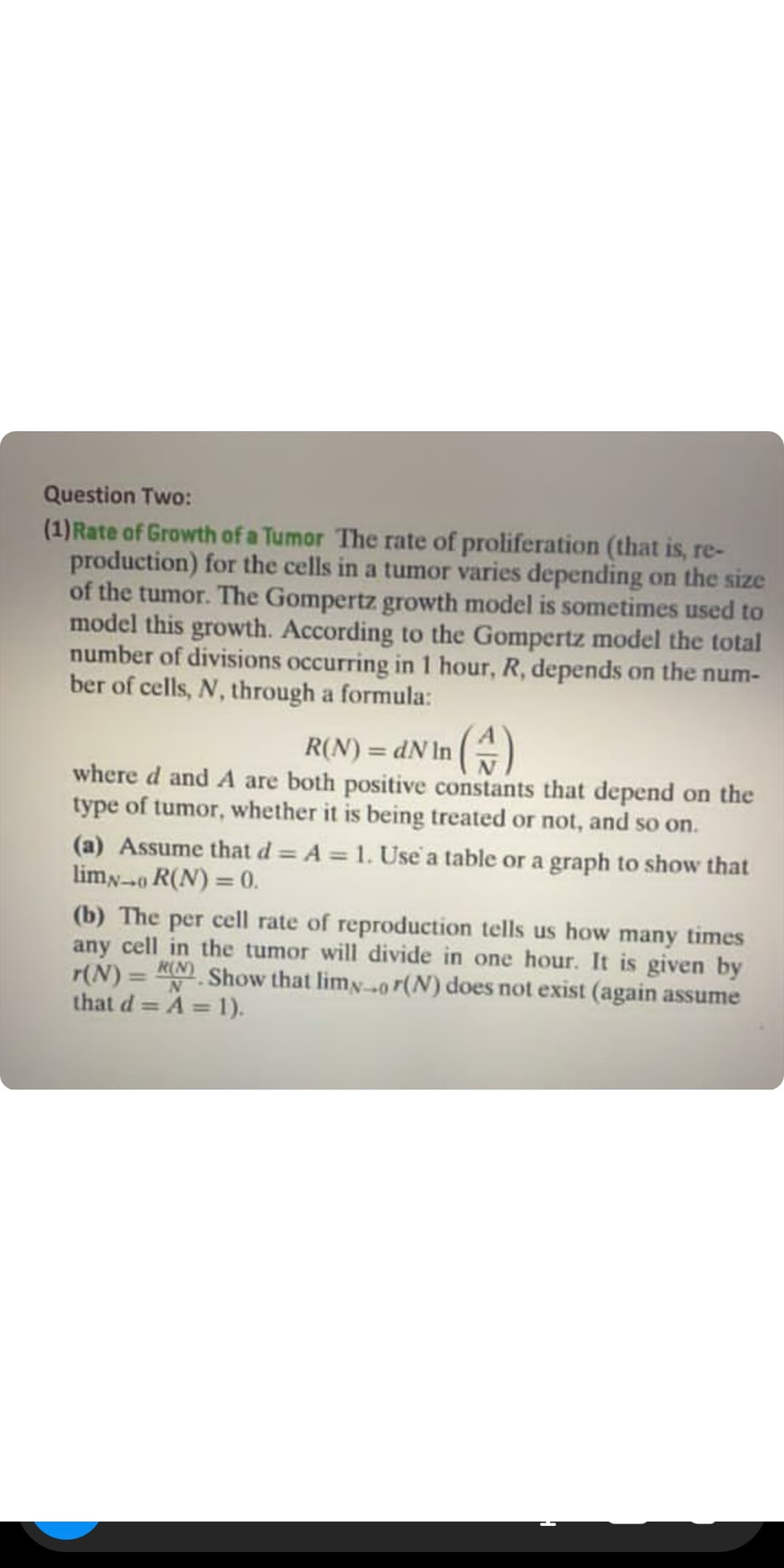(1)Rate of Growth of a Tumor The rate of proliferation (that is, re- production) for the cells in a tumor varies depending on the size of the tumor. The Gompertz growth model is sometimes used to model this growth. According to the Gompertz model the total number of divisions occurring in 1 hour, R, depends on the num- ber of cells, N, through a formula: R(N) = dN In () where d and A are both positive constants that depend on the type of tumor, whether it is being treated or not, and so on. (a) Assume that d = A = 1. Use a table or a graph to show that limN-o R(N) = 0. %3D (b) The per cell rate of reproduction tells us how many times any cell in the tumor will divide in one hour. It is given by r(N) = RN Show that limy-or(N) does not exist (again assume that d = A = 1). %3D
(1)Rate of Growth of a Tumor The rate of proliferation (that is, re- production) for the cells in a tumor varies depending on the size of the tumor. The Gompertz growth model is sometimes used to model this growth. According to the Gompertz model the total number of divisions occurring in 1 hour, R, depends on the num- ber of cells, N, through a formula: R(N) = dN In () where d and A are both positive constants that depend on the type of tumor, whether it is being treated or not, and so on. (a) Assume that d = A = 1. Use a table or a graph to show that limN-o R(N) = 0. %3D (b) The per cell rate of reproduction tells us how many times any cell in the tumor will divide in one hour. It is given by r(N) = RN Show that limy-or(N) does not exist (again assume that d = A = 1). %3D
Algebra & Trigonometry with Analytic Geometry
13th Edition
ISBN:9781133382119
Author:Swokowski
Publisher:Swokowski
Chapter5: Inverse, Exponential, And Logarithmic Functions
Section5.3: The Natural Exponential Function
Problem 37E
Related questions
Question

Transcribed Image Text:Question Two:
(1)Rate of Growth of a Tumor The rate of proliferation (that is, re-
production) for the cells in a tumor varies depending on the size
of the tumor. The Gompertz growth model is sometimes used to
model this growth. According to the Gompertz model the total
number of divisions occurring in 1 hour, R, depends on the num-
ber of cells, N, through a formula:
R(N) = dN In ()
where d and A are both positive constants that depend on the
type of tumor, whether it is being treated or not, and so on.
%3D
(a) Assume that d = A = 1. Use a table or a graph to show that
limN0 R(N) = 0.
(b) The per cell rate of reproduction tells us how many times
any cell in the tumor will divide in one hour. It is given by
= RN Show that limy0 r(N) does not exist (again assume
r(N)
that d = A = 1).
Expert Solution
This question has been solved!
Explore an expertly crafted, step-by-step solution for a thorough understanding of key concepts.
This is a popular solution!
Trending now
This is a popular solution!
Step by step
Solved in 2 steps with 2 images

Knowledge Booster
Learn more about
Need a deep-dive on the concept behind this application? Look no further. Learn more about this topic, advanced-math and related others by exploring similar questions and additional content below.Recommended textbooks for you

Algebra & Trigonometry with Analytic Geometry
Algebra
ISBN:
9781133382119
Author:
Swokowski
Publisher:
Cengage

Algebra & Trigonometry with Analytic Geometry
Algebra
ISBN:
9781133382119
Author:
Swokowski
Publisher:
Cengage